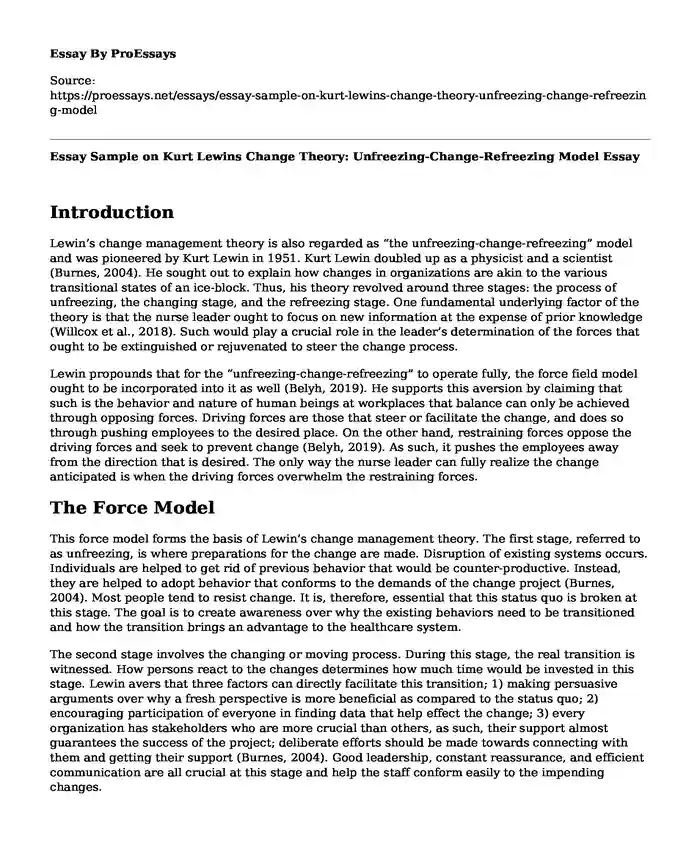Introduction
Lewin’s change management theory is also regarded as “the unfreezing-change-refreezing” model and was pioneered by Kurt Lewin in 1951. Kurt Lewin doubled up as a physicist and a scientist (Burnes, 2004). He sought out to explain how changes in organizations are akin to the various transitional states of an ice-block. Thus, his theory revolved around three stages: the process of unfreezing, the changing stage, and the refreezing stage. One fundamental underlying factor of the theory is that the nurse leader ought to focus on new information at the expense of prior knowledge (Willcox et al., 2018). Such would play a crucial role in the leader’s determination of the forces that ought to be extinguished or rejuvenated to steer the change process.
Lewin propounds that for the “unfreezing-change-refreezing” to operate fully, the force field model ought to be incorporated into it as well (Belyh, 2019). He supports this aversion by claiming that such is the behavior and nature of human beings at workplaces that balance can only be achieved through opposing forces. Driving forces are those that steer or facilitate the change, and does so through pushing employees to the desired place. On the other hand, restraining forces oppose the driving forces and seek to prevent change (Belyh, 2019). As such, it pushes the employees away from the direction that is desired. The only way the nurse leader can fully realize the change anticipated is when the driving forces overwhelm the restraining forces.
The Force Model
This force model forms the basis of Lewin’s change management theory. The first stage, referred to as unfreezing, is where preparations for the change are made. Disruption of existing systems occurs. Individuals are helped to get rid of previous behavior that would be counter-productive. Instead, they are helped to adopt behavior that conforms to the demands of the change project (Burnes, 2004). Most people tend to resist change. It is, therefore, essential that this status quo is broken at this stage. The goal is to create awareness over why the existing behaviors need to be transitioned and how the transition brings an advantage to the healthcare system.
The second stage involves the changing or moving process. During this stage, the real transition is witnessed. How persons react to the changes determines how much time would be invested in this stage. Lewin avers that three factors can directly facilitate this transition; 1) making persuasive arguments over why a fresh perspective is more beneficial as compared to the status quo; 2) encouraging participation of everyone in finding data that help effect the change; 3) every organization has stakeholders who are more crucial than others, as such, their support almost guarantees the success of the project; deliberate efforts should be made towards connecting with them and getting their support (Burnes, 2004). Good leadership, constant reassurance, and efficient communication are all crucial at this stage and help the staff conform easily to the impending changes.
Conclusion
Finally, the refreezing stage comes when stability within the organization has been achieved. Usually, most, if not all, stakeholders have accepted and embraced the changes. Everything begins to function in their normal speed and routine. However, for success to be fully realized, help from all stakeholders is required. Some of the changes may take time to get comfortable (Bennis, Benne & Chinn, 1960). The new state of equilibrium created would be the new normal, and the expectations for the performance levels are higher.
References
Anastacia Belyh. Major Approaches & Models of Change Management. (2019, September 20). Retrieved July 10, 2020, from https://www.cleverism.com/major-approaches-models-of-change-management/
Bennis, W., Benne, K., & Chinn, R. (1960). The planning of change (2nd ed.). New York: Holt, Rinehart, & Winston.
Burnes, B. (2004). Kurt Lewin and complexity theories: Back to the future? Journal of Change Management, 4, 309–325.
Willcox, A., Harris, Y., Whitebear, W., Bazylewski, S., Muller, S., Udod, S., Duchscher, J. (2018, June 30). Common Change Theories and Application to Different Nursing Situations. Retrieved July 10, 2020, from https://leadershipandinfluencingchangeinnursing.pressbooks.com/chapter/chapter-9-common-change-theories-and-application-to-different-nursing-situations/
Cite this page
Essay Sample on Kurt Lewins Change Theory: Unfreezing-Change-Refreezing Model. (2023, Sep 25). Retrieved from https://proessays.net/essays/essay-sample-on-kurt-lewins-change-theory-unfreezing-change-refreezing-model
If you are the original author of this essay and no longer wish to have it published on the ProEssays website, please click below to request its removal:
- Gender in the Workplace Essay
- Charles Manson's Personality Based on Sigmund Freud and Karen Horney's Theories
- The Thread of Organizations: Theories
- Essay Example on John and Emma: Benefits and Harms of Counselling Relationship
- Essay on Gender Differences in Self-Esteem, Anxiety, and Boredom: Considerations for Exercise
- Paper Example on Computer Revolution: Must-Have for CEOs to Ensure Smooth Operations
- Free Essay Example on Leadership







